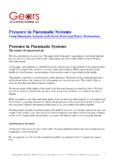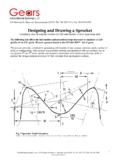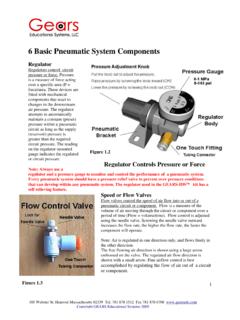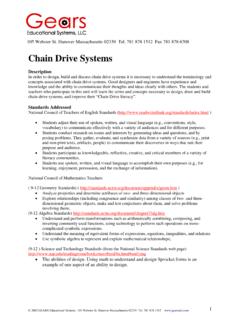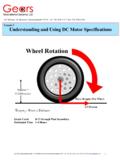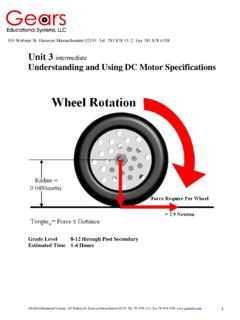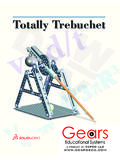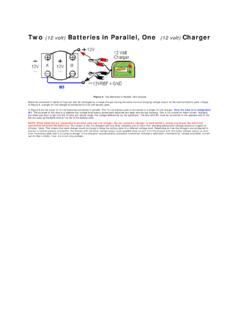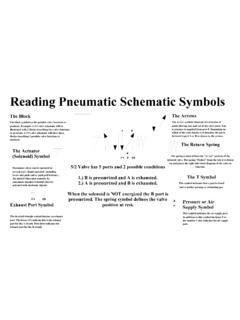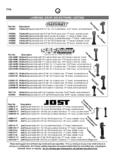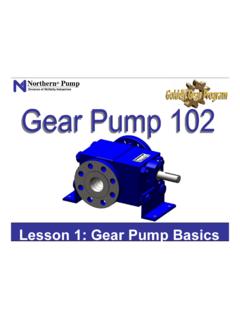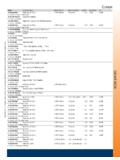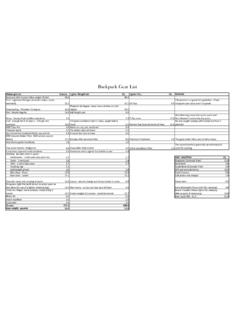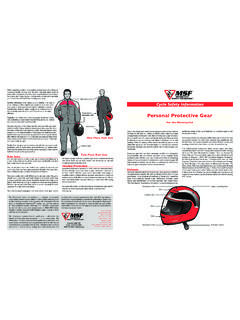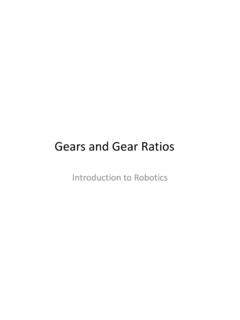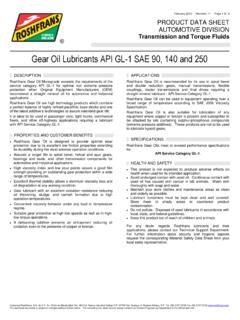Transcription of Spur Gear Terms and Concepts
1 1 GEARS Educational Systems 105 Webster St. Hanover Massachusetts 02339 Tel. 781 878 1512 Fax 781 878 6708 Spur gear Terms and Concepts Description In order to design, build and discuss gear drive systems it is necessary to understand the terminology and Concepts associated with gear systems. Good designers and engineers have experience and knowledge and the ability to communicate their thoughts and ideas clearly with others. The students and teachers who participate in this unit will learn the gear Terms and Concepts necessary to design, draw and build gear drive systems, and improve their gear literacy . Standards Addressed National Council of Teachers of English Standards ( ) Students adjust their use of spoken, written, and visual language ( , conventions, style, vocabulary) to communicate effectively with a variety of audiences and for different purposes.
2 Students conduct research on issues and interests by generating ideas and questions, and by posing problems. They gather, evaluate, and synthesize data from a variety of sources ( , print and non-print texts, artifacts, people) to communicate their discoveries in ways that suit their purpose and audience. Students participate as knowledgeable, reflective, creative, and critical members of a variety of literacy communities. Students use spoken, written, and visual language to accomplish their own purposes ( , for learning, enjoyment, persuasion, and the exchange of information). National Council of Mathematics Teachers ( 9-12 Geometry Standards) ( ) Analyze properties and determine attributes of two- and three-dimensional objects Explore relationships (including congruence and similarity) among classes of two- and three-dimensional geometric objects, make and test conjectures about them, and solve problems involving them; (9-12 Algebra Standards) Understand and perform transformations such as arithmetically combining, composing, and inverting commonly used functions, using technology to perform such operations on more-complicated symbolic expressions.
3 Understand the meaning of equivalent forms of expressions, equations, inequalities, and relations Use symbolic algebra to represent and explain mathematical relationships; (9-12 ) Science and Technology Standards (from the National Science Standards web page) #unifying The abilities of design. Using math to understand and design gear forms is an example of one aspect of an ability to design. 105 Webster St. Hanover Massachusetts 02339 Tel. 781 878 1512 Fax 781 878 6708 2 GEARS Educational Systems 105 Webster St. Hanover Massachusetts 02339 Tel. 781 878 1512 Fax 781 878 6708 Active Profile Addendum Backlash Base Circle Center Distance Chordal Thickness Circular Pitch Circular Thickness Dedendum Diametral Pitch gear Ratios Herringbone Gears Idler gear Involute Module Pitch Pitch Diameter Pitch Point Pressure Angle Profile Rack Spur gear Velocity Whole Depth Working Depth Materials/Equipment/Supplies/Software Pencils 8-1/2 x 11 Paper Compass Protractor Ruler Straight Edge 1-2 String Tin Can Tape GEARS-IDS Kit GEARS-IDS Optional gear Set Objectives.
4 Students who participate in this unit will: 1. Sketch and illustrate the parts of a spur gear . 2. Calculate gear and gear tooth dimensions using gear pitch and the number of teeth. 3. Calculate center to center distances for 2 or more gears in mesh. 4. Calculate and specify gear ratios. Some Things to Know Before You Start How to use a compass How to use a protractor to measure angles How to solve simple algebraic expression. Basic Geometric Terms 3 GEARS Educational Systems 105 Webster St. Hanover Massachusetts 02339 Tel. 781 878 1512 Fax 781 878 6708 Terms and Types Spur gears have been used since ancient times. Figure shows an illustration of the two-man drive system that Leonardo Davinci designed to power a his vision of a helicopter like device.
5 The device never flew, but the gear system works. Modern gears are a refinement of the wheel and axle. gear wheels have projections called teeth that are designed to intersect the teeth of another gear . When gear teeth fit together or interlock in this manner they are said to be in mesh. Gears in mesh are capable of transmitting force and motion alternately from one gear to another. The gear transmitting the force or motion is called the drive gear and the gear connected to the drive gear is called the driven gear . Gears are Used to Control Power Transmission in These Ways 1. Changing the direction through which power is transmitted ( parallel, right angles, rotating, linear etc.)
6 2. Changing the amount of force or torque 3. Changing RPM Fig. Model of Davinci s Helicopter gear Fig. GEARS-IDS gear Drive system 4 GEARS Educational Systems 105 Webster St. Hanover Massachusetts 02339 Tel. 781 878 1512 Fax 781 878 6708 Terms , Concepts and Definitions Spur Gears Are cogged wheels whose cogs or teeth project radially and stand parallel to the axis. Diametral Pitch (DP) The Diametral Pitch describes the gear tooth size. The Diametral Pitch is expressed as the number of teeth per inch of Pitch Diameter. Larger gears have fewer teeth per inch of Diametral Pitch. Another way of saying this; gear teeth size varies inversely with Diametral Pitch. Pitch Diameter (D) The Pitch Diameter refers to the diameter of the pitch circle.
7 If the gear pitch is known then the Pitch Diameter is easily calculated using the following formula; PNPD= Using the values from fig. we find " The Pitch Diameter is used to generate the Pitch Circle. Fig. DP = #Teeth/Pitch Diameter = 36 = 24 Fig. Relative Sizes of Diametral PitchPD = Pitch Diameter N = Number of teeth on the gear P = Diametral Pitch ( gear Size) 5 GEARS Educational Systems 105 Webster St. Hanover Massachusetts 02339 Tel. 781 878 1512 Fax 781 878 6708 Pitch Circle The pitch circle is the geometrical starting point for designing gears and gear trains. gear trains refer to systems of two or more meshing gears. The pitch circle is an imaginary circle that contacts the pitch circle of any other gear with which it is in mesh.
8 See fig. below. The pitch circle centers are used to ensure accurate center-to-center spacing of meshing gears. The following example explains how the center distances of meshing gears is determined using the pitch circle geometry. Example Calculate the center-to-center spacing for the 2 gears specified below. Gears: gear #1) 36 tooth, 24 Pitch Drive gear gear # 2) 60 tooth, 24 Pitch Driven gear Step 1.) Calculate the Pitch Diameter for each of the two gears listed above. Pitch Diameter (D) of gear #1 is: " Pitch Dia. = Pitch Diameter (d) of gear #2 is: " Pitch Dia. = Step 2.) Add the two diameters and divide by 2. Pitch Dia. of gear #1 = Pitch Dia.
9 Of gear #2 = + Sum of both gear diameters = Divide by 2 Sum of both gear diameters = /2 = center to center distance = 2 (This is necessary since the gear centers are separated by a distance equal to the sum of their respective radii.) A simple formula for calculating the center-to-center distances of two gears can be written; Center-to-Center Distance = 221DD+ Fig. illustrates this relationship. Fig. Pitch Circle and gear Teeth in Mesh 6 GEARS Educational Systems 105 Webster St. Hanover Massachusetts 02339 Tel. 781 878 1512 Fax 781 878 6708 Term Definition Calculation Pitch Diameter (D) The diameter of the Pitch Circle from which the gear is designed.
10 An imaginary circle, which will contact the pitch circle of another gear when in mesh. PND= Diametral Pitch (P) A ratio of the number of teeth per inch of pitch diameter DNP= Addendum (A) The radial distance from the pitch circle to the top of the gear tooth PA1= Dedendum (B) The radial distance from the pitch circle to the bottom of the tooth Outside Diameter (OD) The overall diameter of the gear PNOD2+= Root Diameter (RD) The diameter at the Bottom of the tooth PNRD2 = Base Circle (BC) The circle used to form the involute section of the gear tooth BC = D * Cos PA Circular Pitch (CP) The measured distance along the circumference of the Pitch Diameter from the point of one tooth to the corresponding point on an adjacent tooth.
